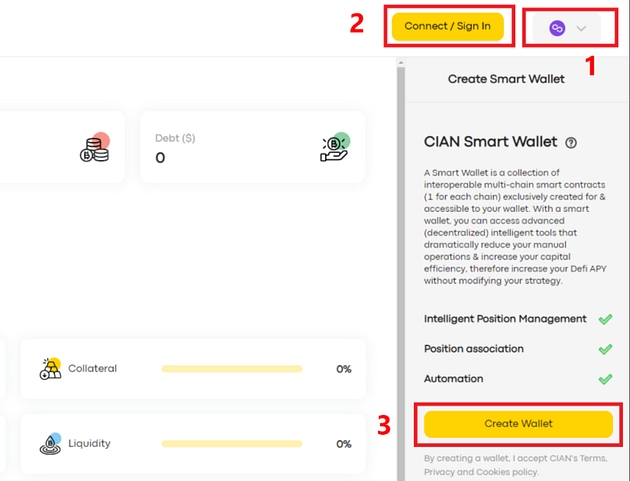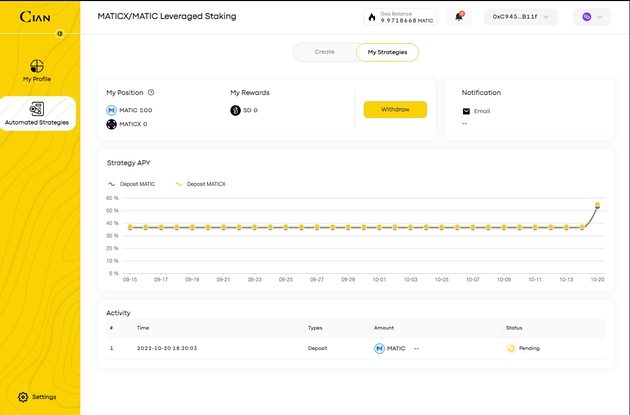MaticX/Matic Recursive Staking (6x)
Overview
The MaticX/MATIC recursive staking strategy enables users to safely leverage MaticX’s staking rewards & supply APY*. This strategy is powered by CIAN, an automation platform for web3, which primarily focuses on staking derivatives and protection/optimization tooling. STADER and CIAN have recently established a strategic partnership aiming to accelerate the evolvement of the MaticX ecosystem.
What are the benefits of MaticX in DeFi?
MaticX is the Matic’s staking derivative provided by Stader, one of the top liquid staking protocols on Polygon, Hedera, BSC, and more. The relation between MaticX and Matic is analogous to that between stETH and ETH.
On POS networks like Polygon, users can stake native tokens (Matic) to increase the network security in exchange for a staking reward. The rise of liquid staking on Stader now allows users to stake native tokens through them to the network for extra benefits: no constraints in the number of tokens & hardware, most notably, receiving staked assets (MaticX) for increased flexibility and extra yield.
What are the steps involved in leveraged staking?
This strategy supports AAVE V3 as the main lending platform.
When applying CIAN’s leveraged staking strategy, the following steps will be executed simultaneously within one transaction:
For this example, let’s assume that the leverage is 3x, that we have 1000 Matic, and that the exchange rate between MaticX and Matic is of 1.
1. Stake* 1000 Matic in Stader to receive 1000 MaticX & passive staking yield;
2. Deposit MaticX in AAVE V3 lending market;
3. Flashloan 2000 Matic from Balancer (leveraged 3x);
4. Stake* the flashloaned 2000 Matic in Stader to receive MaticX, thus extra staking yield;
5. Deposit the extra 2000 MaticX in AAVE V3 lending market;
6. Using 3000 MaticX as collateral, borrow 2000 Matic to repay the flashloan.
Leveraged staking supports both MaticX & Matic as a principal. If users choose MaticX, the system will automatically skip the first step listed above.
*If the Matic/MaticX swap rate is 0.2% superior than the stake rate, the system will swap instead of staking on Stader.
How to calculate the leveraged staking strategy’s APY?
The positive return rate comes from the supply APY (AAVE) + staking rewards (Stader) + CIAN APY. The negative return rate comes from Matic’s borrow interest on AAVE. Here is the formula:
Assuming that the:
Principal: Matic
Exchange rate Matic/MaticX: R
Leverage: 6x
The equation goes as follows: Total APY = 6 x (MATICX Staking Yield + MATICX Supply APR) - 5 x (MATIX Borrow APR)
What are the different costs related to leveraged staking?
1. When executing a leveraged staking strategy, 0% of the total Matic flashloaned will be charged since the system is using Balancer;
2. Normal gas fees incurred by each transaction on AAVE and Stader;
3. Matic borrow interest rate on AAVE;
4. When closing a leveraged staking strategy, users might lose a certain % of their initial position due to exchange fees, and MaticX/Matic exchange rate on DEXes (variable).
It is quite important to understand that, when using such a leveraged strategy, it’s highly advised to intend on holding that position for a while. By doing so, users will give enough time for the high APY to cover their entry & exit costs.
How to use leveraged staking on CIAN?
Select the Polygon chain. Connect your wallet (e.g. Metamask). Create your CIAN smart-wallet.

2. Go to Settings. Select EIP-2612. Enter a period (days) for which you allow CIAN to automate your tasks. Sign.

3. Click on Automated strategies and select “MaticX/Matic Leveraged Staking”.

4. A) Deposit some Matic (location: “gas contract”) to cover all automation-incurred gas fees (minimum deposit of 5 Matic). We recommend keeping at least 8 Matic in your “Gas Contract” for security purposes. B) Select the principal: MaticX or Matic. Select the source: MetaMask Wallet or Smart Wallet. Finally, enter the amount. C) If you want to receive notifications concerning your strategy (e.g. changes in APY, gas fees warning, strategy updates, etc.) you may enter your E-mail address and enable the option. Click on execute.

5. Go to “My Strategies” to check your position status.

6. To permanently close your position, you can, at all times, click on “Withdraw”. Your principal and earned yield would then be redirected to your Smart Wallet. Please be aware that some external costs will apply: flashloan fees, exchange fees, and MaticX/Matic exchange ratio on DEXes (variable).
What risks are related to leveraged staking, and how can they be mitigated?
1. Increase of Matic’s borrowing rate If the demand for Matic in AAVE increases, the borrowing rate might also increase. Assuming that the borrowing rate was to drastically surpass the supply rate, users may suffer losses over time.
Solution: If users notice that the leveraged staking strategy’s APY is slowly approaching zero, they may choose to close their position. (CIAN’s notification system can help prevent this event)
2. Liquidation As the price of MaticX on AAVE is determined by the exchange rate on Stader Liquid Staking, liquidation is unlikely to happen. However, if the loan interest increases as time goes by, we could see the LTV rising which may ultimately cause a liquidation.
Solution: CIAN’s automation primitive — Flash Repay (this feature will eventually be implemented). Assuming that the interest rate was to rapidly rise, thus slowly increasing the LTV close to the liquidation limit, Flash Repay would automatically return the LTV to the preset collateral ratio via a flashloan, thus avoiding liquidation. About STADER
Stader is a non-custodial smart contract-based staking platform that helps you conveniently discover and access staking solutions. We are building key staking middleware infra for multiple PoS networks for retail crypto users, exchanges, and custodians.
Last updated
Was this helpful?